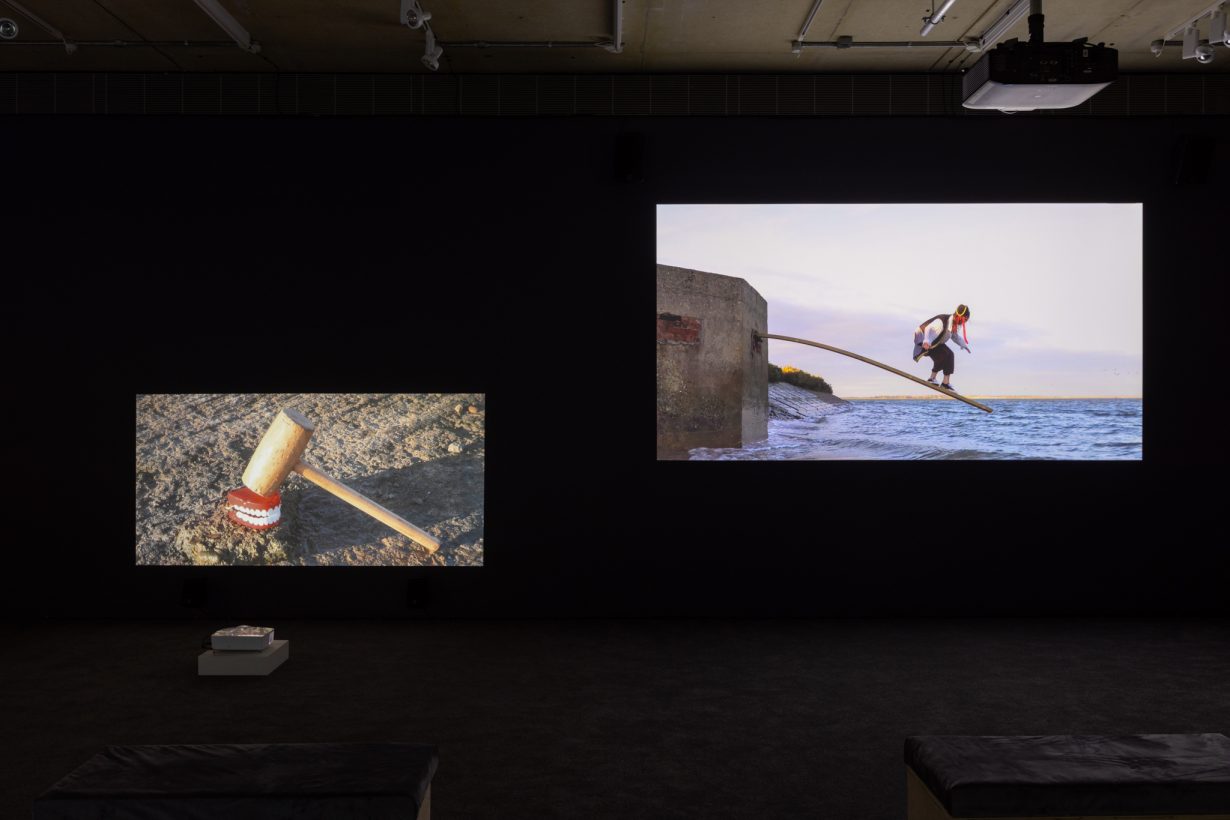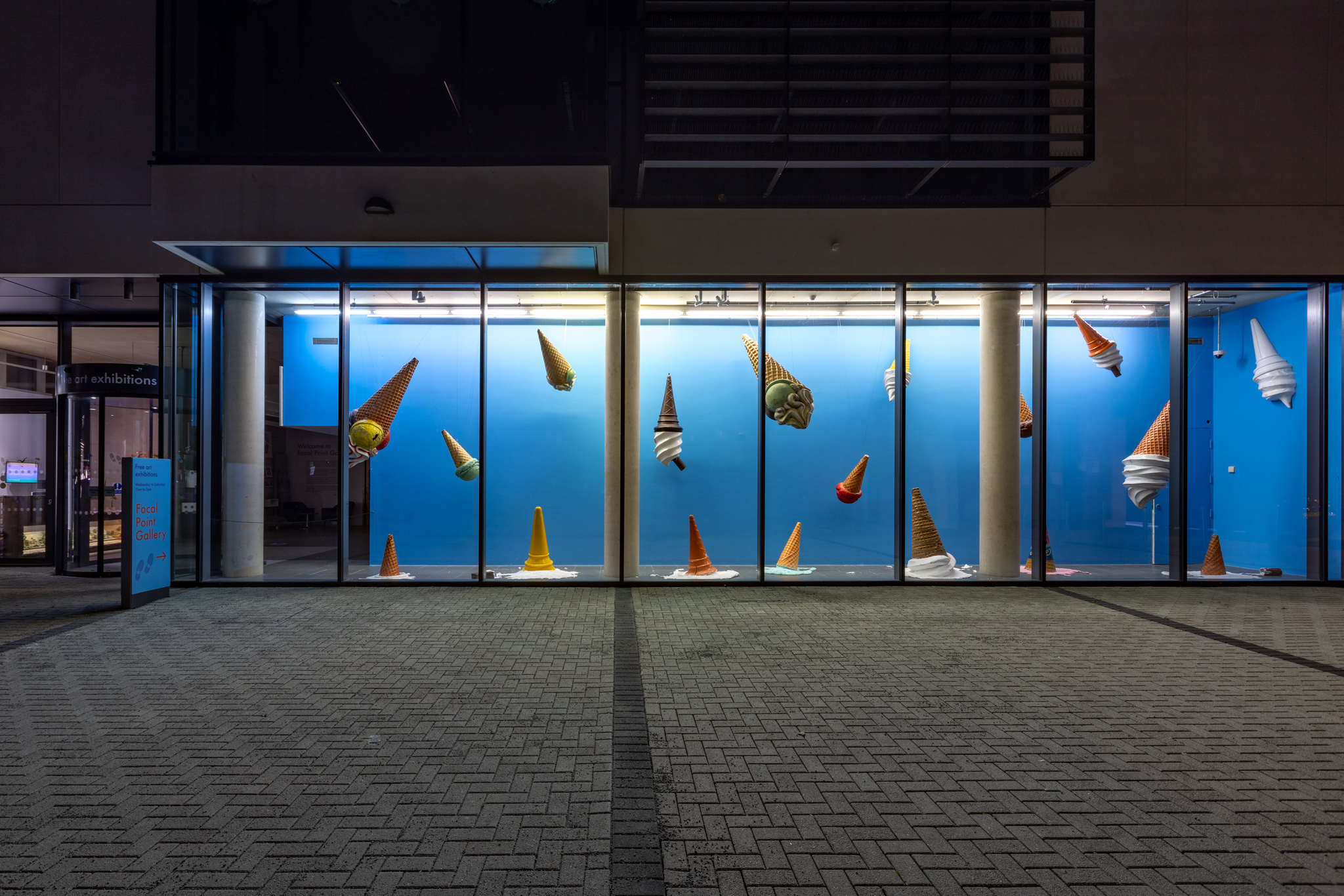The artist’s performances at Focal Point Gallery, Southend-on-Sea echo early Laurel and Hardy and Buster Keaton to invite both laughter and a lingering sadness
A balloon filled with water hangs by a rope from a window. A fluffy cat lies on a duvet on a bed. It rests on the end of the rope, its tail twitching. Outside, a woman sits upright on a chair, knees together, gaze unblinking. With her hands joined on her lap, she might be meditating or even in prayer. Back to the cat, now stretching on its back, one paw reaching out to the pillow, the other clawing the rope. Outdoors again, a wider shot. We see that the woman’s chair is directly beneath the balloon.
Animal Cruelty (2016) lasts just 75 seconds. Each shot is only a few seconds long. The suspense is excruciating. We all know where it is going, but not when it will get there. It is one of six video projections in the Essex-born artist’s first institutional solo show in the UK. Apart from Chitter Chatter (2019), which stars a set of windup teeth and a wooden mallet (and ends on a surprisingly melancholic note), Moss performs in each.
Echoing early Laurel and Hardy films and Moss’s declared inspiration, Buster Keaton, she is entirely focused on whatever bizarre challenge she has set herself: dropping a pair of concrete slabs from a high wall onto a four-tier cake; attempting the tablecloth trick using a boulder and a piece of rope; or walking the plank dressed as a pirate. The shortest video, Shark (2019), is just eight seconds. Wearing a shark outfit and lying on a skateboard, Moss rolls down a concrete slipway towards a group of swans resting at the water’s edge. Laughing uncontrollably, I sit watching this loop after loop after loop.

Unlike Keaton and other male comedians, Moss performs stunts that never put her at any real physical risk. The female Moss is as unambitious and unostentatious as the mundane landscape and occasional buildings in which her works are filmed. She contrives situations which see her body become another object within the Essex landscape. It invites laughter but leaves a lingering sadness too. 23 Days at Sea (2023) documents what initially appears to be a more serious endeavour. A video monitor and archive materials tell the tale of Moss’s journey from Vancouver to Tokyo aboard a vast container ship. What seems to have begun as an inquiry into a multibillion-dollar industry becomes a voyage into absurdity when the boat is denied permission to dock. Along with the crew and a decidedly odd North American couple, Moss is stuck at anchor for an extra 15 days. She records strange conversations about the supply of Nutella and an invitation to go fishing from the deck. When one of her fellow passengers yells, “We’re fucking stuck in a corporate madhouse! And they won’t let us out!” the comedy of their experience speaks back to Moss’s slapstick performances exhibited next door.
The final element of the show, Skydrop (2023), is in the large front window of the gallery. Viewed from the square outside, this is a playful window display of fibreglass and plastic ice-cream sculptures, which Moss bought on eBay and Facebook Marketplace. Some hang as if halted in mid-drop, while below them others stand inverted in their own creamy waste on the floor. The windows’ reflections of the gallery’s seaside town bring the work to life. Seagulls fly, screeching. As I stand gazing in, an elderly couple passes by. The woman is chuckling and enthusing, “Now that’s clever, that’s very clever.” Beside her, the old man looks bemused. And then I notice that one of Moss’s giant ice-creams appears to be falling, quite perfectly, on to his reflected head.
Unstable Condition at Focal Point Gallery, Southend-on-Sea, 28 June – 16 September
